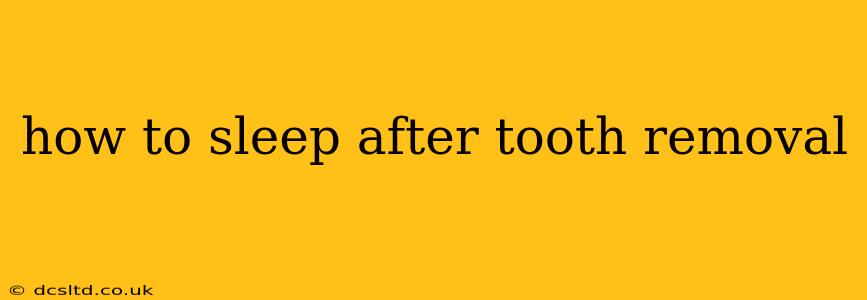Having a tooth extracted can be a somewhat unsettling experience, and knowing how to best manage the recovery process, especially sleep, is crucial for healing. This guide will cover essential tips and techniques to help you get comfortable and promote a restful night's sleep after your tooth extraction. We'll address common concerns and answer frequently asked questions to ensure a smooth recovery.
What's the Best Position to Sleep In After Tooth Extraction?
The ideal sleeping position after a tooth extraction is on your back, slightly elevated. Propping your head and upper body up with extra pillows helps to minimize swelling and bleeding. Sleeping on your side, especially the side of the extraction, can put pressure on the wound and potentially dislodge the blood clot, leading to a painful condition called dry socket. Avoid sleeping on your stomach entirely.
How Can I Reduce Swelling and Discomfort While Sleeping?
Swelling and discomfort are common after tooth extraction. Here are some effective strategies to minimize these issues while you sleep:
- Ice Packs: Apply ice packs to your cheek for 15-20 minutes at a time, several times a day, especially in the first 24-48 hours. This helps reduce inflammation and numb the area, making sleep more comfortable. Wrap the ice pack in a thin cloth to protect your skin.
- Elevation: Keeping your head elevated helps reduce swelling and blood flow to the extraction site. Use extra pillows to achieve a comfortable incline.
- Pain Medication: Follow your dentist's instructions regarding pain medication. Taking pain relievers as prescribed can help manage discomfort and allow for better sleep. Do not exceed the recommended dosage.
- Gentle Pressure: If your dentist recommends it, applying gentle pressure with a gauze pad can help control bleeding and minimize discomfort while you sleep.
How Long Should I Expect Discomfort After Tooth Extraction?
The level of discomfort varies depending on the complexity of the extraction. Most people experience some pain and swelling for the first few days, gradually improving over a week or two. However, severe pain or persistent swelling should be reported to your dentist immediately.
Can I Use a Mouthwash After Tooth Extraction?
Your dentist will likely advise you on the use of mouthwash. Generally, you should avoid rinsing vigorously in the first 24 hours to prevent dislodging the blood clot. After that, you might be recommended a gentle salt water rinse to help keep the area clean and promote healing. Always follow your dentist's specific instructions.
What Are the Signs of a Dry Socket?
A dry socket occurs when the blood clot at the extraction site is dislodged, exposing the bone and nerve endings. This is extremely painful. Symptoms include severe pain, a persistent bad taste in your mouth, and sometimes a visible empty socket. If you suspect a dry socket, contact your dentist immediately. Prompt treatment is crucial.
When Should I Call My Dentist After Tooth Extraction?
Contact your dentist immediately if you experience:
- Severe pain that is not relieved by medication.
- Excessive bleeding that doesn't stop after several hours of applying pressure.
- Signs of infection such as swelling, redness, or pus.
- A dry socket.
- Difficulty swallowing or breathing.
Following these tips can significantly improve your sleep quality and overall recovery after tooth extraction. Remember, proper post-operative care is essential for a quick and comfortable healing process. If you have any concerns or questions, always consult your dentist or oral surgeon.
